You can Download KSEEB Solutions for Class 8 Science Chapter 7 Force and Pressure Questions and Answers Pdf, Notes help you to revise the complete syllabus.
KSEEB Solutions for Class 8 Science Chapter 7 Force and Pressure
Force and Pressure Textbook Questions and Answers
Question 1.
Give two examples each of situations in which you push or pull to change the state of motion of objects.
Answer:
Two examples in which push changes the state of motion of objects are:
- The football player kicking the football.
- The hockey player hitting the ball will hockey.
Two examples in which pull changes the state of motion of objects are:
- Pulling out water from the well by pulling rope.
- Opening of a box in the table by pulling it.
Question 2.
Give two examples of situations in which applied force causes a change in the shape of an object.
Answer:
- We can change the shape of a lump of dough by pressing it down with our hands.
- We can change the shape of the seat of a bicycle by sitting on it.
![]()
Question 3.
Fill in the blanks in the following statements.
- To draw water from a well we have to ________ at the rope.
- A charged body ________ an uncharged body towards it.
- To move a loaded trolley we have to ________ it.
- The north pole of a magnet ________ the north pole of another magnet.
Answer:
- To draw water from a well we have to pull at the rope.
- A charged body attracts an uncharged body towards it.
- To move a loaded trolley we have to pull it.
- The north pole of a magnet repels the north pole of another magnet.
Question 4.
An archer stretches her bow while taking aim at the target. She then releases the arrow, which begins to move towards the target. Based on this information, fill up the gaps in the following statements using the following terms.
muscular, contact, non-contact, gravity, friction, shape, attraction
- To stretch the bow, the archer applies a force that causes a change in its ________
- The force applied by the archer to stretch the bow is an example of ________ force.
- The type of force responsible for a change in the state of motion of the arrow is an example of a ________ force.
- While the arrow moves towards its target, the forces acting on it are due to ________ and that due to ________ of air.
Answer:
- To stretch the bow, the archer applies a force that causes a change in its shape.
- The force applied by the archer to stretch the bow is an example of muscular force.
- The type of force responsible for a change in the state of motion of the arrow is an example of a contact force.
- While the arrow moves towards its target, the forces acting on it are due to gravity and that due to friction of air.
![]()
Question 5.
In the following situations identify the agent exerting the force and the object on which it acts. State the effect of the force in each case.
(а) Squeezing a piece of lemon between the fingers to extract its juice.
(b) Taking out paste from a toothpaste tube.
(c) A load suspended from a spring while its other end is on a hook fixed to a wall.
(d) An athlete making a high jump to clear the bar at a certain height.
Answer:
(а) The agent exerting the force is our muscles (muscular force). The force is exerted on a lemon. The effect of force is that it changes the shape of the lemon and juice is extracted.
(b) The agent exerting the force is our muscles muscular force). The force is exerted on the toothpaste tube. The effect of force is that it changes the shape of the toothpaste tube due to which paste comes out.
(c) The agent exerting the force is the load (non-contact force). The force is exerted on spring and the effect is that the spring expands.
(d) The agent exerting the force is the speed of an athlete. The force is exerted on the body of the athlete. The effect is that he can make his body jump the bar.
Question 6.
A blacksmith hammers a hot piece of iron while making a tool. How does the force due to hammering affect the piece of iron?
Answer:
A blacksmith hammers a hot piece of iron while making a tool. The muscular force applied changes the shape of piece of iron. It flatters and becomes thinner than earlier.
Question 7.
An inflated balloon was pressed against a wall after it has been rubbed with a piece of synthetic cloth. It was found that the balloon sticks to the wall. What force might be responsible for the attraction between the balloon and the wall?
Answer:
The electrostatic force is responsible for the attraction between the balloon and the wall.
Question 8.
Name the forces acting on a plastic bucket containing water held above ground level in your hand. Discuss why the forces acting on the bucket do not bring a change in its state of motion.
Answer:
The forces acting on the bucket are:
- The pressure of water contained in it exerted on its wall and on the base of the bucket.
- Force of gravity by the earth.
The forces acting on the bucket do not bring a change in its state of motion because the net effect of force on it is zero.
![]()
Question 9.
A rocket has been fired upwards to launch a satellite in its orbit. Name the two forces acting on the rocket immediately after leaving the launching pad.
Answer:
The two forces that are acting on the rocket immediately after leaving the launching pad are:
- Force of gravity of earth acting downward, and
- the frictional force produced by air particles.
Question 10.
When we press the bulb of a dropper with its nozzle kept in water, the air in the dropper is seen to escape in the form of bubbles Once we release the pressure on the bulb, water gets filled in the dropper. The rise of water in the dropper is due to
(a) the pressure of water.
(b) the gravity of the earth.
(c) the shape of a rubber bulb.
(d) atmospheric pressure.
Answer:
(d) Atmospheric pressure
Force and Pressure Additional Questions and Answers
Question 1.
How can we decide whether an object is moving faster than the other?
Answer:
By finding the speed of both the objects.
Question 2.
What does the distance move by an object in unit time indicate?
Answer:
The distance moved by an object in unit time is known as speed.
Question 3.
What makes an object slow Down or go faster, or change its direction of motion?
Answer:
Force makes an object slow down or go faster, or change its direction of motion.
Question 4.
What do you do to make a football move?
Answer:
We push the football by kicking it.
![]()
Question 5.
What has to do done to move an object?
Answer:
To move an object, it has to be pushed or pulled.
Question 6.
What is force?
Answer:
A push or a pull on an object is called a force.
Question 7.
In the figures given below:
(i) Who is pushing whom
(ii) Who is pulling whom.

Answer:
- In fig (a), both the girls appear to push each other i.e., they are applying force on each other.
- If fig (b) the pair of girls are trying to pull each other i.e. they are applying force on each other.
- In fig (c) the cow and the man appear to pull each other i.e., they are applying force on each other.
Question 8.
In the game of tug of wax if two teams pull the rope with equal force then the rope will move in which direction?
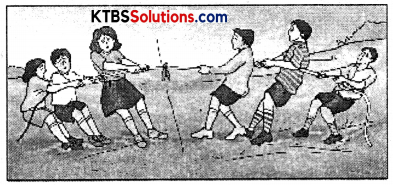
Fig. The rope may not move if the two teams pull at it with equal force
Answer:
The rope does not move in any direction.
![]()
Question 9.
When do we add forces?
Answer:
Forces applied on an object in the same direction add to one another.
Question 10.
Give some examples where force can change the state of motion and direction of an object?
Answer:
Examples, where force can change the state of motion and direction of an object, are:
- A hockey player in-game constantly changes the state of motion and direction of the ball by hitting it with a hockey stick.
- In a game of volleyball, players often push the moving ball to their teammates to make a winning move. This changes the state of motion and direction of the ball.
Question 11.
What effects are produced by force?
Answer:
Force can produce one or more effects:
- It can bring a stationary object into motion.
- It can change the speed of moving objects.
- It can change the direction of a moving object.
- It can change the shape of an object.
Question 12.
What is muscular force?
Answer:
The force resulting due to the action of muscles is known as the muscular force.
![]()
Question 13.
Can you push or lift a book lying on a table without touching it?
Answer:
No.
Question 14.
What is a non-contact force?
Answer:
The non-contact force acts between two objects without being in contact with each other.
Question 15.
What is magnetic force?
Answer:
The force exerted by a magnet is magnetic force.
Question 16.
What happens when the same poles of two magnets are brought near each other and what happens when different poles of two magnets are brought near each other.
Answer:
When the same poles of two magnets are brought near each other then there is repulsion when different poles of two magnets are brought near each other then there is attraction.
![]()
Question 17.
The effect of force depends on which things?
Answer:
The effect of a force depends on two things:
- The amount of force applied the more force applied the greater the effect.
- The area on which the force is applied the smaller the area the force is applied on, the greater the effect.
Question 18.
What is the meaning of Pressure?
Answer:
The force on a unit area (perpendicular to the surface) is called pressure.
Question 19.
I have seen fountains of water coming out of the leaking joints or holes in pipes supplying water. Is it not due to the pressure exerted by water on the walls of the pipes?
Answer:
Yes, this is due to the pressure exerted by water on the walls of the pipes.
Question 20.
Do gases also exert pressure? Do they also exert pressure on the walls of their containers? Let us find out.
Answer:
Yes, gases exert pressure on the walls of their containers.
Question 21.
What is the atmosphere?
Answer:
The envelope of air around us is called the atmosphere.
![]()
Question 22.
What is atmospheric pressure?
Answer:
Everything around is being pressed by a column of air. This pressure is called atmospheric pressure.
Activities
Activity 1.
Table 7.1 gives some examples of familiar situations involving the motion of objects. You can add more such situations or replace those given here. Try to identify action involved in each case as a push and/or a pull and record your observations. One example has been given to help you.
Table 7.1: Identifying Actions as Push or Pull
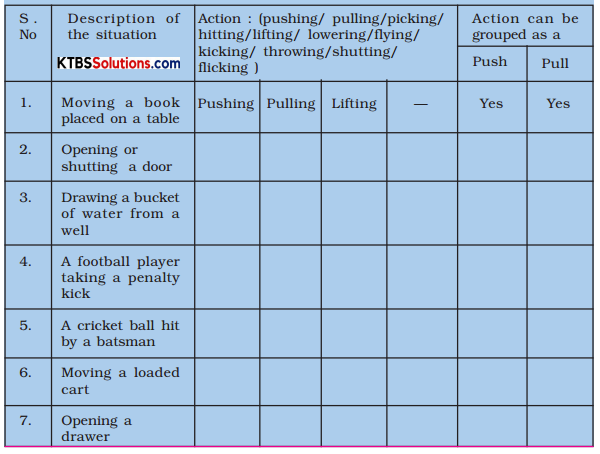
Answer:
Table 7.1: Identifying Actions as Push or Pull
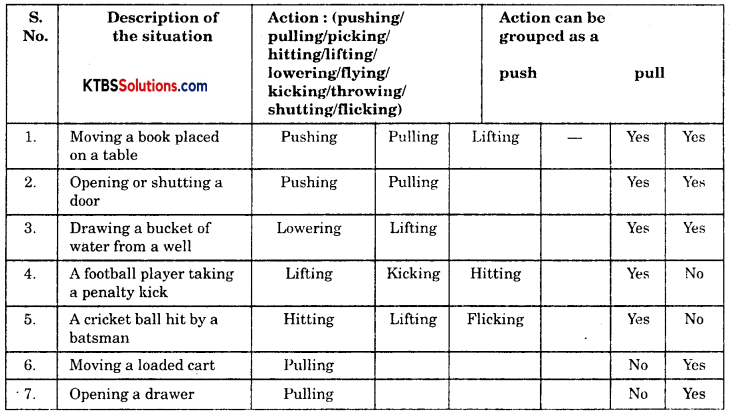
Do you notice that each of the actions can be grouped as a pull or push or both? Can we infer from this that to move an object it has to be pushed or pulled?
Answer:
Yes, they can be grouped as a push or pull, and from this we can infer that to move an object, it has to be pushed or pulled or sometimes both.
![]()
Activity 2.
(i) Choose a heavy object like a table or a box, which you can move only by pushing hard. Try to push it all by yourself. Can you move it? Now ask one of your friends to help you in pushing it in the same direction [Fig. (a)]. Is it easier to move it now? Can you explain why?
(ii) Now push the same object, but ask your friend to push it from the opposite side [Fig. (b)]. Does the object move? If it does, note the direction in which it moves. Can you guess which one of you is applying a larger force?
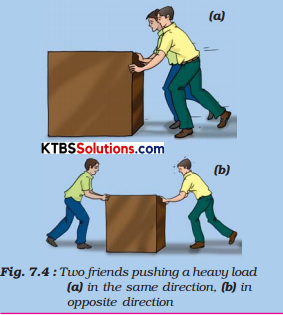
Answer:
(i) I can not move it. It is easier to move it with the help of my friend because now the applied force has increased.
(ii) The object will not move. If it moves than the direction in which it is moving, the larger force is applied by a person from the opposite side.
Activity 3.
Take a rubber ball and place it on a level surface such as a tabletop or a concrete floor. Now, gently push the ball along the level surface (Fig).

Question (i).
Does the ball begin to move?
Answer:
Yes.
![]()
Question (ii).
Push the ball again while it is still moving. Is there any change in its speed? Does it increase or decrease?
Answer:
Yes, there is a change in its speed. It increases. Next, place your palm in front of the moving ball. Remove your palm as soon as the moving ball touches it.
Question (iii).
Does Your palm apply a force on the ball? What happens to the speed of the ball now?
Answer:
The palm applies a force which makes the ball slow down.
Question (iv).
Does it increase or decrease? What would happen if you let your palm hold the moving ball?
Answer:
The speed of the ball decreases. If the palm holds the moving ball, then the ball stops and comes to rest.
Activity 4.
Take a ball and place it on a level surface as you did in Activity 3. Make the ball move by giving it a push. Now place the ruler from your geometry box in its path as shown in Fig. In doing so, you would apply a force on the moving ball.
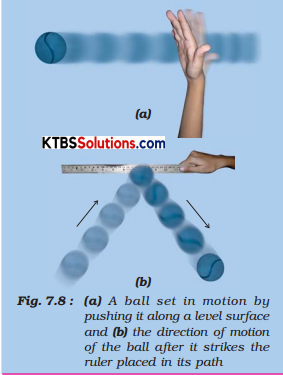
Question (i).
Does the ball continue to move in the same direction after it strikes the ruler?
Answer:
No, the ball will come to rest.
Question (ii).
Repeat the activity and try to obstruct the moving ball by placing the ruler in such a way that it makes different angles to its path. In each case note your observations about the direction of motion of the ball after it strikes the ruler.
Answer:
In this case, the ball will not stop, but it will change its direction with a slower motion.
![]()
Activity 5.
Some situations have been given in Column 1 of Table 7.2 in which objects are not free to move. Column 2 of the Table suggests the manner in which a force can be applied to each object while Column 3 shows a diagram of the action. Try to observe the effect of the force in as many situations as possible. You can also add similar situations using available material from your environment. Note your observations in Columns 4 and 5 of the Table.
Table 7.2: Studying the Effect of Force on Objects
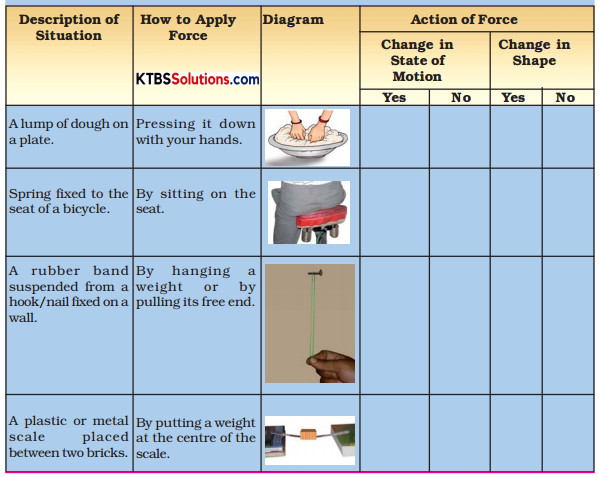
Question (i).
What happens when you apply a force on an inflated balloon by pressing it between your palms?
Answer:
The shape of the inflated balloon is changed.
Question (ii).
What happens to the shape of a ball of dough when it is rolled to make a chapati?
Answer:
The shape is changed.
Question (iii).
What happens when you press a rubber ball placed on a table?
Answer:
The shape of the ball is changed.
Activity 6.
Take a pair of bar magnets. Place the longer side of one of the magnets over three round-shaped pencils or wooden rollers as shown in Fig. Now bring one end of the other magnet near the end of the magnet placed on the rollers. Make sure that the two magnets do not touch each other.
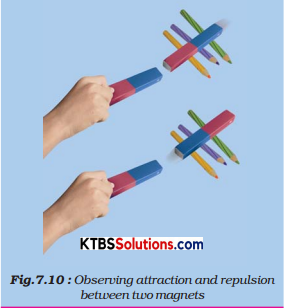
Question (i).
Observe what happens. Next, bring the other end of the magnet near the same end of the magnet placed on the rollers (Fig.). Note what happens to the magnet placed on the rollers every time another magnet is brought near it.
Answer:
The first attraction took place. When another end of the second magnet is brought to the same end of the magnet on the roller, it moved away from it, showing that repulsion is taking place. In the second case, the first repulsion took place, and then attraction took place.
![]()
Question (ii).
Does the magnet on the rollers begin to move when the other magnet is brought near it? Does it always move in the direction of the approaching magnet?
Answer:
Yes, the magnet on the rollers begins to move when the other magnet is brought near it. No, it always does not move in the direction of the approaching magnet. The attraction takes place only when opposite poles are brought nearby and repulsion will take place when similar poles are brought nearby.
Question (iii).
What do these observations suggest? Does it mean some force must be acting between the two magnets?
Answer:
The observations suggest the following:
(i) The force of attraction takes place between the opposite nature of forces.
(ii) The force of repulsion takes place between similar nature of forces.
Yes, some force is acting between the two magnets.
Question (iv).
Do you have to bring the magnets in contact for observing the force between them?
Answer:
No. A magnet can exert a force on another magnet without being in contact with it.
Activity 7.
Take a plastic straw and cut it into nearly two equal pieces. Suspend one of the pieces from the edge of a table with the help of a piece of thread (Fig.). Now hold the other piece of straw in your hand and rub its free end with a sheet of paper. Bring the rubbed end of the straw near the suspended straw. Make sure that the two pieces do not touch each other.
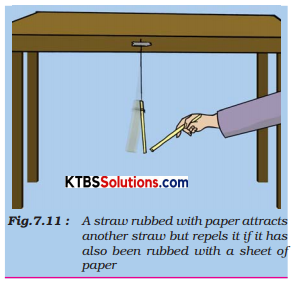
Question (i).
What do you observe?
Answer:
The suspended straw attracts towards the straw in hand.
![]()
Question (ii).
Next, rub the free end of the suspended piece of straw with a sheet of paper. Again, bring the piece of straw that was rubbed earlier with paper near the free end of the suspended straw. What do you observe now?
Answer:
There is repulsion between the straws in this case.
Activity 8.
Take a transparent glass tube or a plastic pipe. The length of the pipe/tube should be about 15cm and its diameter should be 5 – 7.5cm. Also, take a piece of a thin sheet of good quality rubber, say, a rubber balloon. Stretch the rubber sheet tightly over one end of the pipe. Hold the pipe in the middle, keeping it in a vertical position (Fig.). Ask one of your friends to pour some water into the pipe.
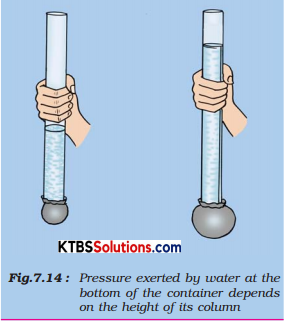
Fig. Pressure exerted by water at the bottom of the container depends on the height of its column
Question (i).
Does the rubber sheet bulge out?
Answer:
Yes, the rubber sheet bulges out when the water column in the cylinder rises. Note also the height of the water column in the pipe. Pour some more water. Observe again the bulge in the rubber sheet and the height of the water column in the pipe. Repeat this process a few more times.
Question (ii).
Can you see any relation between the amount of the bulge in the rubber sheet and the height of the water column in the cylinder?
Answer:
The pressure of the liquid is directly proportional to the liquid column in the containing cylinder.
![]()
Activity 9.
Take a plastic bottle. You can take a discarded water or soft drink bottle. Fix a cylindrical glass tube, a few cm long near its bottom as shown in Fig. You can do so by slightly heating one end of the glass tube and then quickly inserting it near the bottom of the bottle. Make sure’ that the water does not leak from the joint. If there is any leakage, seal it with molten wax. Cover the mouth of the glass tube with a thin rubber sheet as you did in Activity. Now fill the bottle upto half with water. What do you observe? Why does the rubber sheet fixed to the glass tube bulge this time? Pour some more water in the bottle.
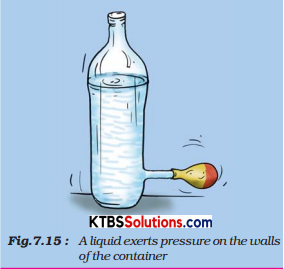
Question (i).
Is there any change in the bulge of the rubber sheet?
Note that the rubber sheet has been fixed on the side of the container and not at the bottom.
Answer:
It is due to the water pressure in the bottle this time also. If some more water is poured into the bottle, the pressure of water increases, and the bulge in the rubber sheet increases.
Question (ii).
Does the bulging of the rubber sheet, in this case, indicate that water exerts pressure on the sides of the container as well?
Answer:
Yes, the bulging of the rubber sheet, in this case, indicates that water exerts pressure on the sides of the container as well.
Activity 10.
Take an empty plastic bottle or a cylindrical container. You can take a used tin of talcum powder or a plastic bottle. Drill four holes all around near the bottom of the bottle. Make sure that the holes are at the same height from the bottom (Fig.). Now fill the bottle with water.
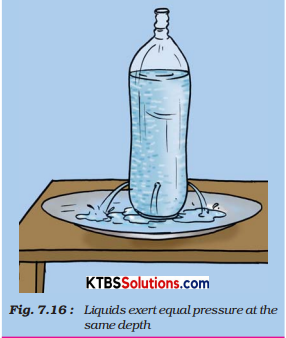
Question (i).
What do you observe?
Answer:
Water starts pouring out from all the holes.
Question (ii).
Do the different streams of water coming out of the holes fall at the same distance from the bottle? What does this indicate?
Answer:
Yes, different streams of water coming out of the holes fall at the same distance from the bottom. This indicates that liquids exert equal pressure at the same depth.
![]()
Question (iii).
Can you now say that liquids exert pressure on the walls of the container?
Answer:
Yes.
Activity 11.
Take a good-quality rubber sucker. It looks like a small rubber cup (Fig.).
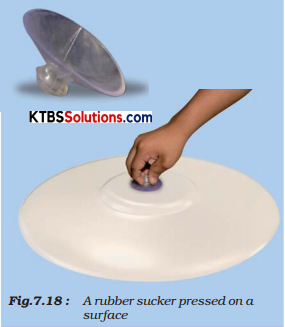
Press it hard on a smooth plane surface. Does it stick to the surface? Now try to pull it off the surface. Can you do it?
Answer:
Yes, it sticks to the surface very hard. I cannot pull it.
Question (ii).
Does it give you an idea of how large the atmospheric pressure is?
Answer:
Yes, it gives us an idea that the atmospheric pressure is very large.